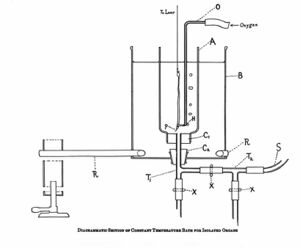Chemistry:Organ bath

An organ chamber, organ bath, or isolated tissue bath, is a chamber in which isolated organs or tissues can be administered with drugs, or stimulated electrically, in order to measure their function. The tissue in the organ bath is typically oxygenated with carbogen and kept in a solution such as Tyrode's solution or lactated Ringer's solution.[citation needed] Historically, they have also been called gut baths.[1]
Overview
It is used in pharmacology research, particularly when studying the contraction of smooth muscle in tissues such as ileum,[2] colon,[3] vas deferens,[4] trachea,[5] bladder,[6] corpus cavernosum,[7] and blood vessels such as aortic rings. The contraction of smooth muscle tissues can be readily measured with a myograph; this type of physiological response is more readily quantifiable than that of other tissues. Organ baths were originally developed to study the effects of agonists and antagonists on excitable tissues, such as nervous tissue and muscle though they have been adapted to study tissues such as epithelium.[8] Typical tissues and receptors studied with organ bath preparations include nicotinic, muscarinic, and histamine receptors in the ileum or beta adrenoceptors in the bladder.[8] Tissues are typically taken from rodents, such as guinea pigs, mice, and rats.
For studying the effects of drugs on receptors in drug discovery and combinatorial chemistry, novel techniques such as high throughput screening, ultrahigh throughput screening and high content screening, pharmacogenomics, proteomics, and array technology have largely superseded the use of organ baths.[9] These techniques can allow more receptor specificity than organ bath preparations, as a single tissue sample can express many different receptor types.[citation needed]
The use of organ bath preparations for the measurement of physiological tissue responses to drug concentrations allows the generation of dose response curves. This in turn allows the quantification of a drug's pharmacological profile in the tissue in question, such as the calculation of the drug's EC50, IC50, and Hill coefficient.[citation needed]
Historical contributions
Examples of important contributions made using this technique include:
- The 1921 discovery by Otto Loewi of Vagusstoff using frog hearts resulted in the identification of acetylcholine as the first neurotransmitter.[10]
- Enkephalin using bioassays such as the mouse vas deferens as a bioassay.[11]
- Nitric oxide using both assays of bull retractor penis and aortic ring.[12]
References
- ↑ Handley, Sheila L.; Singh, Lakhbir (January 1986). "Neurotransmitters and shaking behaviour — more than a 'gut-bath' for the brain?". Trends in Pharmacological Sciences 7: 324–328. doi:10.1016/0165-6147(86)90371-8.
- ↑ Albuquerque, AA; Carvalho, MT; Evora, PM; de Nadai, TR; Celotto, AC; Evora, PR (June 2016). "In vitro reactivity ("organ chamber") of guinea pig tracheal rings-methodology considerations.". Annals of Translational Medicine 4 (11): 216. doi:10.21037/atm.2016.05.18. PMID 27386490.
- ↑ Briejer, MR; Akkermans, LM; Schuurkes, JA (1995). "Interactions of serotonin with multiple receptors and neurotransmitters in the guinea-pig isolated colon.". Archives Internationales de Pharmacodynamie et de Thérapie 329 (1): 121–33. PMID 7639614.
- ↑ Burnstock, G; Verkhratsky, A (March 2010). "Vas deferens--a model used to establish sympathetic cotransmission.". Trends in Pharmacological Sciences 31 (3): 131–9. doi:10.1016/j.tips.2009.12.002. PMID 20074819.
- ↑ Spina, D (June 2002). "Airway nerves: neurotransmitter release.". Current Opinion in Pharmacology 2 (3): 283–5. doi:10.1016/S1471-4892(02)00160-1. PMID 12020471.
- ↑ Fry, CH (2004). "Experimental models to study the physiology, pathophysiology, and pharmacology of the lower urinary tract.". Journal of Pharmacological and Toxicological Methods 49 (3): 201–10. doi:10.1016/j.vascn.2004.03.002. PMID 15172016.
- ↑ Dong, Q; Deng, S; Wang, R; Yuan, J (February 2011). "In vitro and in vivo animal models in priapism research.". The Journal of Sexual Medicine 8 (2): 347–59. doi:10.1111/j.1743-6109.2010.02052.x. PMID 20946160.
- ↑ 8.0 8.1 Langton, Philip D. (2012). Essential Guide to Reading Biomedical Papers.
- ↑ Vogel, Hans (2008). Drug Discovery and Evaluation: Pharmacological Assays (3 ed.). pp. 9–10. ISBN 978-3-540-70995-4.
- ↑ Bennett, Max R. (March 2000). "The concept of transmitter receptors: 100 years on". Neuropharmacology 39 (4): 523–546. doi:10.1016/S0028-3908(99)00137-9. PMID 10728874.
- ↑ Goldberg, Jeff (2013). Anatomy of a Scientific Discovery: The Race to Find the Body's Own Morphine. Skyhorse Publishing. ISBN 9781626361935. https://books.google.com/books?id=zXAhAgAAQBAJ&pg=PT20.
- ↑ Martin, W (October 2009). "Robert F. Furchgott, Nobel laureate (1916-2009)--a personal reflection.". British Journal of Pharmacology 158 (3): 633–7. doi:10.1111/j.1476-5381.2009.00418.x. PMID 19681890.
 |

